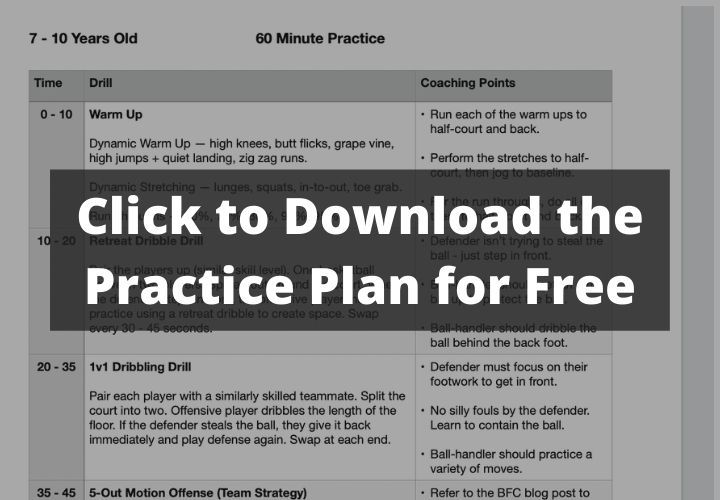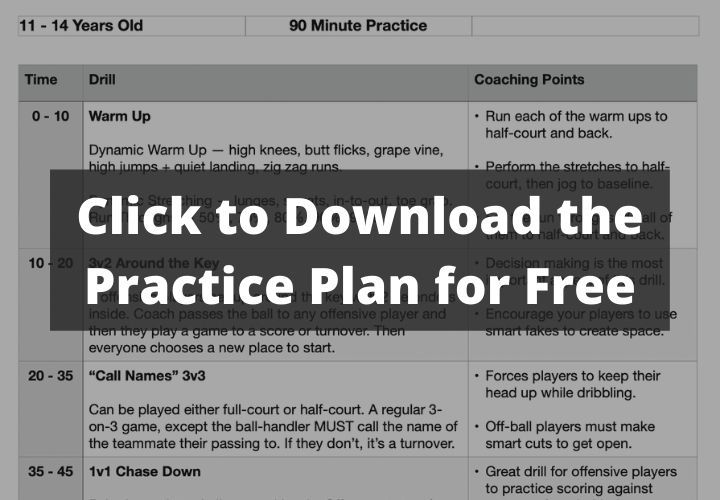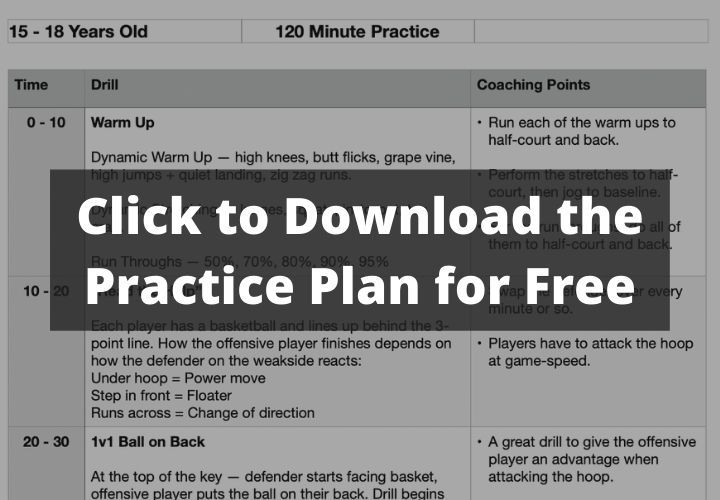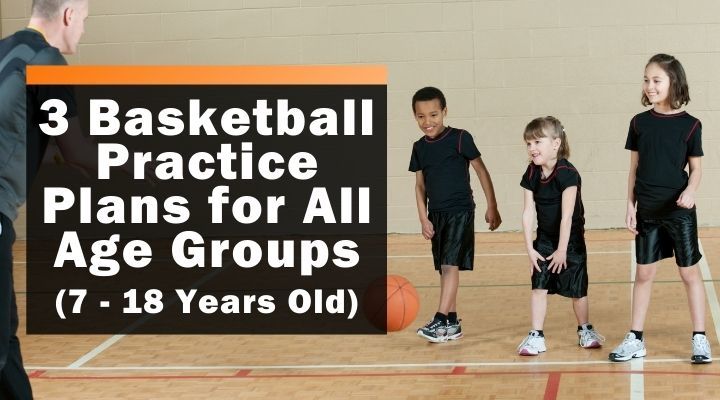
“Players win games. Coaches win practices”.
Practices are the time coaches have the biggest opportunity to impact the basketball skills of a player…
However, I constantly attend practices that are inefficiently run.
The coach spends half of practice trying to work out what drill to run next.
All coaches should be spending the majority of their time encouraging and providing feedback to their players… not working out what the next drill is going to be.
How do coaches fix this and make practices more efficient?
Create a basketball practice plan.
Two of the greatest coaches of all time knew how important a practice plan was…
“I always designed my practice plans the night before and then made tweaks a few hours before practice began” – Bobby Knight
“I would spend almost as much time planning a practice as conducting it. Everything was planned out each day” – John Wooden
Having a plan for each practice is absolutely essential.
Here is how to do it:
Basketball Practice Plan Structure
At Basketball For Coaches, we break down a typical practice into 5 sections…
1. Dynamic Warm-Up/Body Movement
2. Skill Work
3. Team Strategies
4. Scrimmage/Small Sided Games
5. Cool Down
First, let’s discuss each section in more detail.
Later on we’ll break down how long you should spend on each of the sections.
And then I’ll share 3 complete practice plans that you can print off and use with your team.
1. Dynamic Warm-Up/Body Movement
This section of practice cannot be skipped.
Most youth teams perform a 2-minute warm-up before moving immediately on to other sections of practice.
When I watch youth basketball games, it becomes quickly apparent that the best players have fantastic:
- Balance
- Coordination
- Change of Speed
- Change of Direction
The players who struggle haven’t learned how to control their bodies yet.
It’s extremely important to help players establish an athletic foundation. With this foundation in place, it becomes much easier to learn new basketball skills as they progress.
This section of practice will help your players with much more than their basketball skills. It will help prevent injuries and will help them in all sports and movements of life, because as we all know, players shouldn’t be specializing solely in basketball at a young age.
Here are a few examples of body movement and coordination movements you need to incorporate into your dynamic warm-up.
- Jogging
- Sprinting
- Backpedaling
- Sliding
- Change of Direction
- Change of Pace
- Jumping
- Landing
- Lunging
- Skipping
2. Skill Work
The bulk of a youth basketball practice should be skill work. The drills should be fun and interesting while still improving the skill of your players.
This includes drills that teach players how to perform the skill movement correctly, along with drills that assist them to learn when to use the skill.
Drills that allow the player to learn when to use the skill are commonly skipped over.
Referring to shooting, this is a great quote by Jeff Van Gundy…
“Shooting percentage is just as much about decision making as it is about technique” – Jeff Van Gundy
This rule goes for all skills, not just shooting…
We need to put players in positions that require them to make decisions and gain game-like experience.
A lot of coaches will show players exactly what they need to do… they’ll give fantastic instructions, and the players will eventually look brilliant at training.
Then, the players will get into the game and it’ll look like they’ve forgotten everything!
Why does this happen?
Because they haven’t learned to play against competition.
We need to include drills that will teach players the technique, and drills that will teach them when to do it in the game.
I recommend splitting these two types of drills up 50/50…
Dribbling Example:
5 minutes of stationary ball handling and then a game of 1v1 in the full-court.
Shooting Example:
5 minutes of shooting form and then 1-on-1 partner close-outs with the offensive player deciding whether to shoot the ball or drive.
Passing Example:
5 minutes of form passing and then a 10 minute game of 5 vs 4 keep-away.
While I list small-sided games at the end of practice, I still use them in this section to improve individual skills while making decisions.
“Perform drills that force your players to think” – Bobby Knight
BFC TIP: At the youth level, drills should be no more than 10 minutes long. The players will start to become disinterested after that time. Keep them short and fun!
3. Team Strategies
Team strategies are the least important component of a youth basketball practice.
And in my opinion, they are not necessary for players under the age of 10.
The team strategies section of training includes:
- Offense
- Defense
- Set Plays
- Special Situations
If you decide to use this section of practice with your team, dedicate only a small amount of time to it.
Too many coaches steal practice time from skill development and spend half of practice helping athletes memorize set plays.
Remember that we want to teach our players how to play basketball, not give them a couple of spots on the floor they have to run to each possession.
So, I’m not opposed to teaching team strategies… I’m just opposed to spending half of your valuable practice time on it.
Only practice team strategy for the recommended amount of time, or less.
4. Scrimmages / Small Sided Games
Scrimmages and small-sided games are very important to include in every basketball practice plan.
What’s the point in your players learning how to do a crossover with great technique if they don’t understand when to use it in a game?
Technique is important, of course… but allowing kids to practice when to use it is just as important.
This doesn’t mean letting them loose in a 5-on-5 game every practice…
Most of the game-play in a youth practice should be “small-sided”.
Small-Sided Games (SSG’s) have fewer participants on each team than a normal game. (1v1, 2v1, 3v3, etc.)
There are many benefits to using small-sided games with your players:
- More Touches
- More Space to Practice Moves
- More Opportunities to Score Points
- and many more
Small-sided games result in the players developing quicker and having a lot more fun!
If you have more than one ring and basketball available, play multiple small-sided games!
Another thing I love to do in scrimmages or small-sided games is incorporate rules to work on different skills.
For example, one of my favorite rules is the “no dribble” rule, which forces kids to read the play and make cuts to get open.
Without this rule, you’ll find it’s common for a youth player to take 5 or 6 dribbles with their head down before throwing a wild hook shot at the ring while 3 of their teammates stand around wide open.
5. Cool Down
The cool down section of your training should consist of a couple of minutes of slow jogging and walking up and down the court and then a few minutes of static stretching.
This allows the body to decrease in temperature and begin to flush out the waste products (lactic acid), amongst other things.
The stretching part of the cool down is a great time to talk to the players. We might talk about an upcoming game/tournament or how we felt practice went.
Recommended Practice Plan Structure
Now that you understand each section of practice, let’s work out how much time during practice should be dedicated to each section.
The first thing you’ll need to decide is if you’ll be implementing any team concepts like offenses, defenses, or set plays. If so, I still recommend only spending the listed amount of time on it.
If not, I recommend adding the extra minutes to skill work.
The following is how I generally divide up the minutes depending on the length of practice time you have.
60 Minutes
Dynamic Warm-Up/Body Movement – 10 minutes
Skill Work – 25 minutes
Team Strategy – 10 minutes
Scrimmage/SSG – 10 minutes
Cool Down – 5 minutes
90 Minutes
Dynamic Warm-Up/Body Movement – 10 minutes
Skill Work – 45 minutes
Team Strategy – 15 minutes
Scrimmage/SSG – 15 minutes
Cool Down – 5 minutes
120 Minutes
Dynamic Warm-Up/Body Movement – 10 minutes
Skill Work – 60 minutes
Team Strategy – 20 minutes
Scrimmage/SSG – 20 minutes
Cool Down – 5 minutes
This structure combines the technical learning of the skill with the practical application of the skill.
Too many practices overlook teaching players when to use skills.
3 Sample Basketball Practice Plans
7 – 10 Years Old (60 Minute Practice)
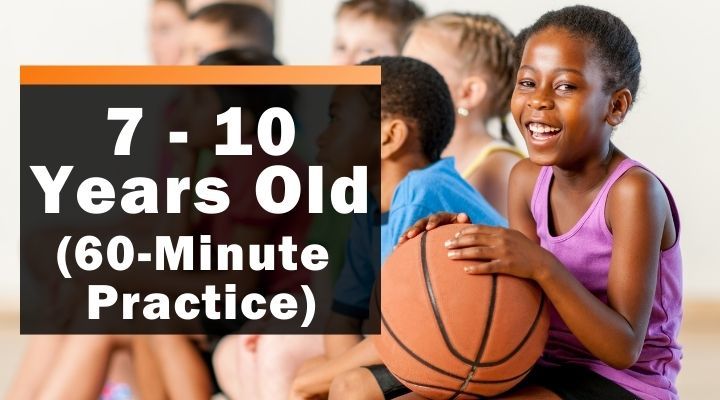
Disclaimer: This training session has been designed for a half-court, as most teams this young only have access to half the court to train on.
Practice Goal: Bringing the ball up the court against pressure.
Warm-Up (0-10 Minutes)
Dynamic Warm-Up
Run each of the following to half-court and back:
1. High Knees – Bring knees to waist height while running.
2. Butt Flicks – Flick the rear with your heels as you run.
3. Grape Vine – Face side-on, step with the front leg, alternate stepping in front and behind with the rear leg.
4. High Jumps, Quiet Landing – Run forward, plant with two feet, jump as high as you can, land as quietly and softly as possible.
5. Zig Zag – Run to the right diagonal for a few steps, plant your outside foot, push off and cut to the left diagonal. Repeat.
Dynamic Stretching
Perform through to half-court, jog back to the baseline.
1. Lunges – Take a large step forward, keep the back upright and the hips straight, slowly drop down until your rear knee is just above the floor.
2. Squats – Take a few steps, stop with feet wider than shoulder-width apart. Keep the back straight, stick out the rear end, and squat down until the thighs are parallel with the ground.
3. In to Out – Take a few steps, lift right knee to waist height. Keep the hips pointing forward, and bring the knee from pointing forwards, to pointing sideways. Drop the foot back down, take a few steps, and repeat with the left knee.
4. Toe Grab – Take a few steps, put your right heel on the ground out in front of you, keeping your right leg straight. Bend down and grab onto your toe. Hold for two seconds, stand up, and repeat after a few steps with your left foot.
Run Throughs
Run each to half court and back.
1. 50% Speed
2. 70% Speed
3. 80% Speed
4. 90% Speed
5. 95% Speed
Skill Work (10 to 35 minutes)
Retreat Dribble Drill (10 to 20 Minutes)
Setup:
Pair the players up (similar skill level). One basketball between two players. Spread out around the court.
Instructions:
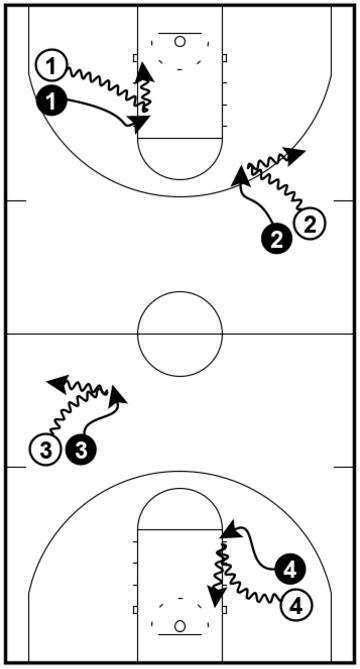
- Have the player with the ball jog and dribble in any direction. The other player acts as the defender.
- At any moment, have the defensive player sprint and stand directly in front of the offensive player.
- Upon this cue, the offensive player shall plant their front foot, push off it hard, and hop back to create space!
- Have the offensive player change the direction they’re dribbling in.
- The defensive player chases the offensive player, and steps in front of them again.
- After 30-45 seconds, have the players switch jobs.
Coaching Points:
The defensive player isn’t trying to steal the ball, or truly pressure the offensive player! They are only there to help show the offensive player when they should be making this move. They are helping the offensive player learn.
1v1 Dribbling Drill (20 to 35 minutes)
Setup:
Pair each player with a similarly skilled teammate. Split the court into two playing with an imaginary line between the baskets (otherwise known as the split line, use cones to mark if you wish).
Instructions:
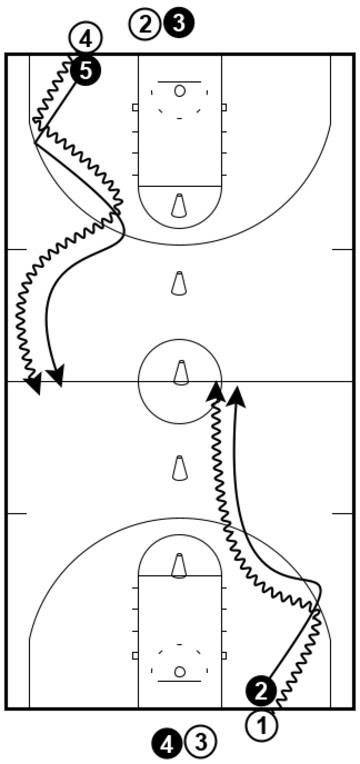
- Starting on the baseline, the offensive player must dribble the ball across the half-court line.
- If the defensive player steals the ball, they must give it back to the offensive player.
- If the offensive player loses control of the ball or goes out of bounds, they must retrieve it and start again where they last had control of the ball.
Team Strategy (35 to 45 minutes)
Three Options:
Scrimmage/SSG (45 to 55 minutes)
3-on-3 “Touchdown”
Setup:
The offense starts with the ball, out-of-bounds on the baseline. They must inbound the ball, and dribble and pass it to half court.
Instructions:
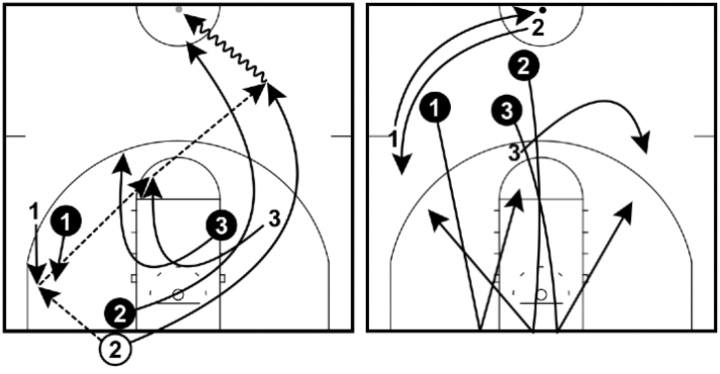
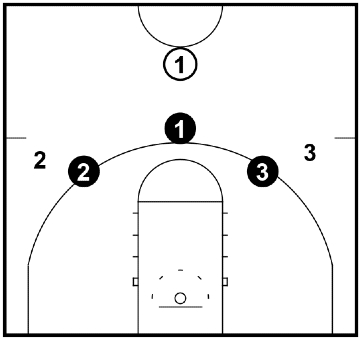
- If the defense gets the ball, the game stops, and they become the offense.
- The game begins again out-of-bounds on the baseline.
- Once the offense get the ball to half court, they must place it on the ground, on the half-court line.
- Another offensive player (who didn’t place the ball on the ground) must sprint to retrieve the ball. They then turn around and look to score on the basket.
- Once the ball has been placed, the defensive team must all turn around and touch the baseline with their hand.
Coaching Points:
As coach, give limited feedback during the game! If you see a certain mistake three times in a row, give advice quickly, but spend most of your time observing. How they perform in this small-sided game should inform how you design your next training session!
Cool Down (55 to 60 minutes)
- Jog to the other end of the court and back.
- Walk to the other end of the court and back.
- Sit down, and do some static stretches.
The cooldown stretching gives the coach some time to have a conversation with the players about training, and potentially some quick information about the next opponent.
[divider style=’full’]
11 – 14 Years Old (90-Minute Practice)
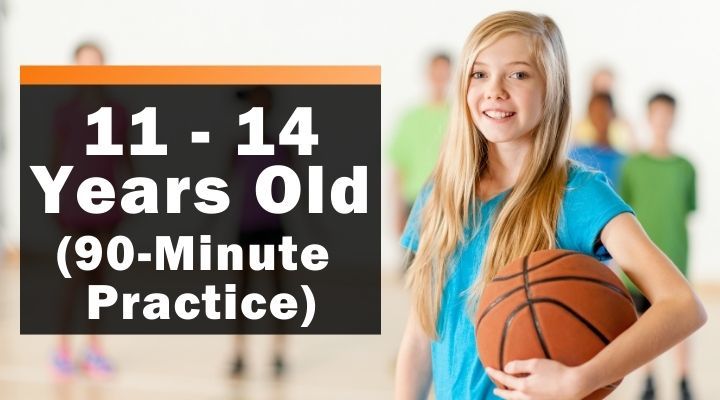
Disclaimer: This training session has been designed for a full-court.
Pre-Training Talk (-15 to -10 minutes)
Before your time on the court begins, share a very clear goal for training with the players. Each training session should have a purpose. For a 90-minute training session, there is enough time to practice two “goals for training”.
Example goals:
- Passing Decision-Making
- Transition Defence
Foam Rolling (-10 to 0 minutes)
Once kids are 11 or older, I highly recommend that each player owns a foam roller for use before training.
Teenage years are renowned for growing pains, and as coaches, we can help our players by dedicating the last 10 minutes before entering the court to foam rolling.
They’re very cheap, and if a player forgets theirs, they can use their own basketball.
Roll each area for 20 seconds each:
- Glutes
- Between the back and the outside of the upper leg.
- Outside of the upper leg.
- Between the front and the outside of the upper leg.
- Front of the upper leg.
- Inside of the upper leg.
- Calf (lower leg)
Warm-Up (0 to 10 minutes)
Dynamic Warm-Up
Run each of the following to half-court and back:
1. High Knees – Bring knees to waist height while running.
2. Butt Flicks – Flick the rear with your heels as you run.
3. Grape Vine – Face side-on, step with the front leg, alternate stepping in front and behind with the rear leg.
4. High Jumps, Quiet Landing – Run forward, plant with two feet, jump as high as you can, land as quietly and softly as possible.
5. Zig Zag – Run to the right diagonal for a few steps, plant your outside foot, push off and cut to the left diagonal. Repeat.
Dynamic Stretching
Perform through to half-court, jog back to the baseline.
1. Lunges – Take a large step forward, keep the back upright and the hips straight, slowly drop down until your rear knee is just above the floor.
2. Squats – Take a few steps, stop with feet wider than shoulder-width apart. Keep the back straight, stick out the rear end, and squat down until the thighs are parallel with the ground.
3. In to Out – Take a few steps, lift right knee to waist height. Keep the hips pointing forward, and bring the knee from pointing forwards, to pointing sideways. Drop the foot back down, take a few steps, and repeat with the left knee.
4. Toe Grab – Take a few steps, put your right heel on the ground out in front of you, keeping your right leg straight. Bend down and grab onto your toe. Hold for two seconds, stand up, and repeat after a few steps with your left foot.
Run Throughs
Run each to half court and back.
1. 50% Speed
2. 70% Speed
3. 80% Speed
4. 90% Speed
5. 95% Speed
Skill Work (10 to 55 minutes)
3v2 Around the Key (10 to 20 minutes)
Setup:
One offensive player on each block (side of the keyway), one starts behind the FT line. One defensive player starts under the front of the basket, and the other starts two steps directly in front of him.
Instructions:
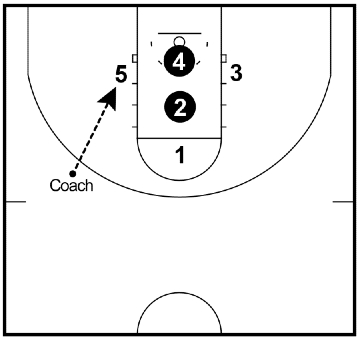
- Coach passes the ball to any of the offensive players.
- A game is played until the offense scores or the defense has the ball (or the ball goes out of bounds)
- Everybody chooses a new place to start, and the game begins again when the coach passes the ball.
Coaching Points:
When you’re coaching this drill, make sure to focus upon the decision making of their passing. We have clearly told the players what the goals of training are, and we must coach to that. If you give all kinds of different advice to the players, it’ll be difficult for them to take it all in.
‘Call Names’ 3v3 (20 to 35 minutes)
Setup:
Depending on numbers and space, play a 3v3 game in the full court, or two 3v3 games in each half-court.
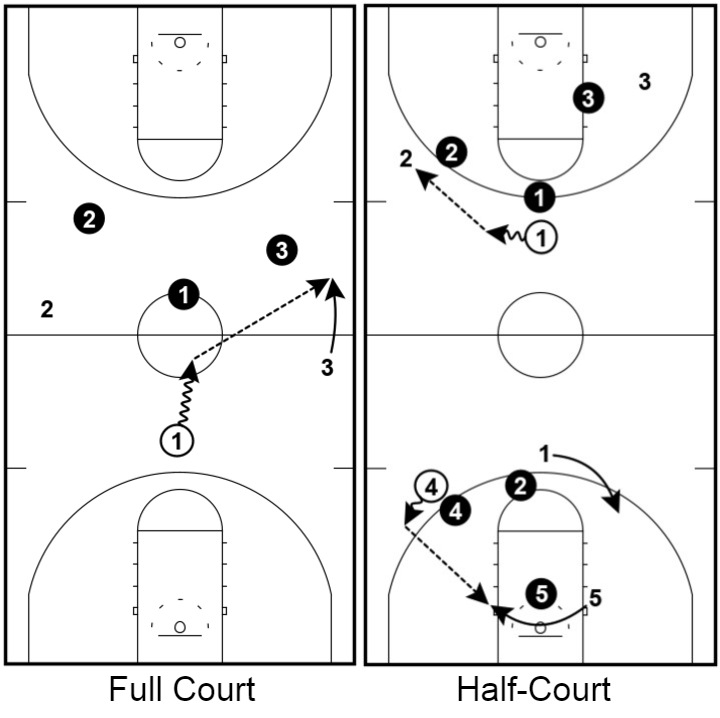
This is a normal 3v3 game, with an extra rule to force the players to make passing decisions while they’re dribbling, not after they’ve finished dribbling.
Rule:
The ball-handler must call the name of the teammate they’re passing the ball to either (a) before passing the ball, or (b) before they pick up their dribble.
If a player passes the ball or picks up their dribble before calling the name of a teammate to pass to, it is a turnover!
1v1 Chase Down (35 to 45 minutes)
Setup:
Pair the players up into similar speed levels. The offense starts a few steps onto the court, either on the left or right side of the court. The defense starts a step or two behind.
Depending on the speed of the defensive player and the speed dribbling ability of the offensive player, you’ll need to adjust where they begin.
Instructions:
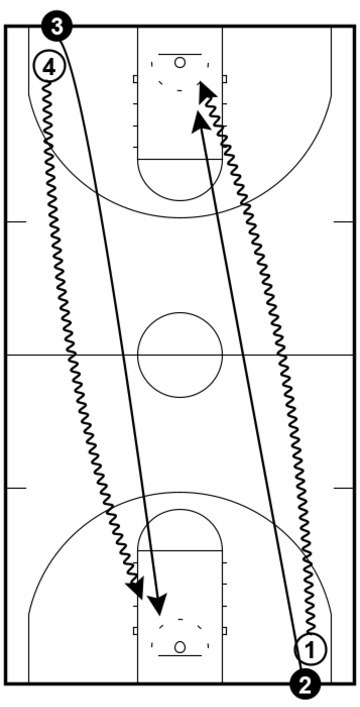
- The coach blows his whistle, and the offense begins speed dribbling towards the basket at the opposite end.
- The defense has to sprint and get in front of the offensive player.
- Play until either the offense scores or the defense has the ball (or the ball goes about of bounds).
Balance the Floor 3v3 (45 to 55 minutes)
Rules:
If you’re below the free-throw line when a shot is attempted, go for the rebound!
If you’re above the free-throw line when a shot is attempted, sprint back onto safety!
When either team has the ball, it is a normal game of 3v3.
Instructions:
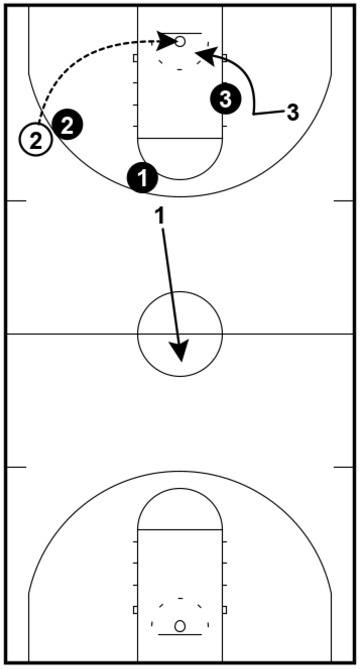
Once a shot is taken, the offensive players must either:
(b) Sprint back towards the half-court line if they’re above the FT line
(a) Sprint to the basket and attempt to make a rebound if they’re below the FT line.
If the defense gets the ball, the drill stops, and everybody freezes. If the offense gets the ball, they may shoot it again and continue to play.
Once the defense gets the ball (and everybody freezes), the coach can observe how the offense (who have just become defense) have ‘balanced the floor’.
Team Strategy (55 to 70 minutes)
Three Options:
Scrimmage/SSG (70 to 85 minutes)
Play a full-court game, with as many players as you have!
Ideally 5v5, but 4v4 or 3v3 would work too.
To help the game express the goals of training that we have been working on (passing decision-making, transition defense), we will add an extra rule.
Rule: If you shoot the ball, you must touch the baseline before rejoining the play!
This rule puts more pressure on defensive transition than a normal game, and therefore they’ll have to do a better job to be able to prevent an easy fast-break basket for the opponent.
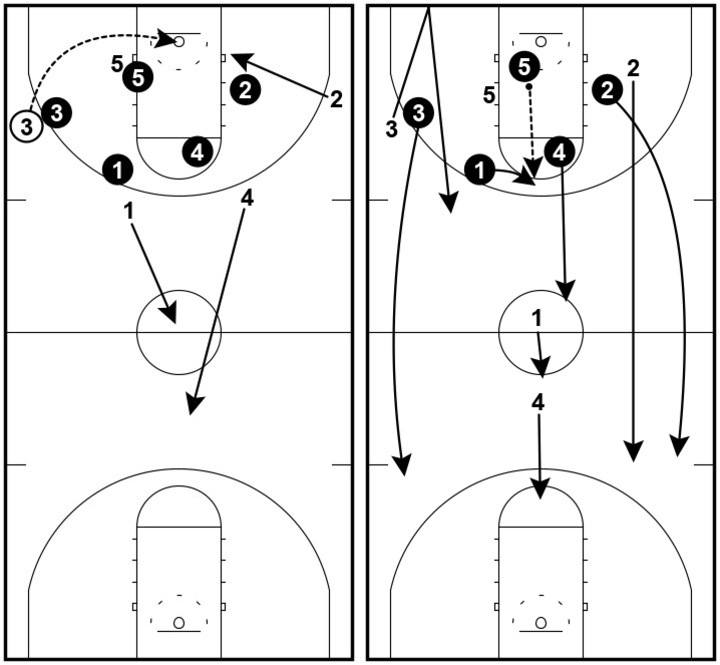
The momentary 5v4 advantage for the offense also allows more opportunities to display their passing decision-making.
Cool Down (85-90 minutes)
- Jog to the other end of the court and back.
- Walk to the other end of the court and back.
- Sit down, and do some static stretches.
The cooldown stretching gives the coach some time to have a conversation with the players about training, and potentially some quick information about the next opponent.
[divider style=’full’]
15 – 18 Years Old (120-Minute Practice)
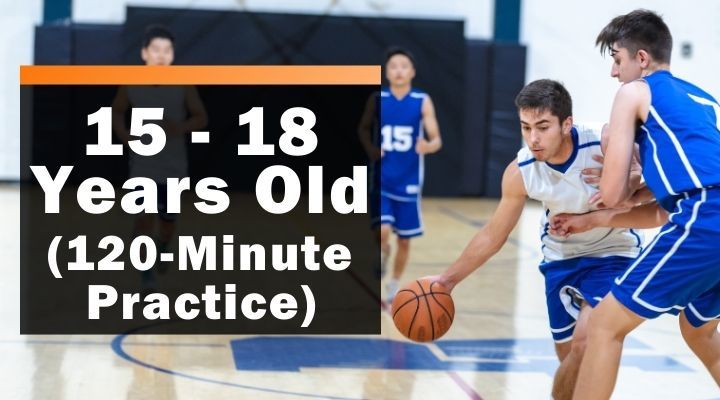
Disclaimer: This training session has been designed for a full-court.
Pre-Training Talk (-15 to -10 minutes)
Before your time on the court begins, share a very clear goal for practice with the players. Each basketball practice should have a purpose. For a 120-minute session, there is enough time to practice three ‘goals for training’.
Example Goals:
- 1v1 Finishing
- Full Court Man to Man
- Defensive Rebounding
Foam Rolling (-10 to 0 minutes)
Once kids are 11 or older, I highly recommend that each player owns a foam roller for use before training.
Teenage years are renowned for growing pains, and as coaches, we can help our players by dedicating the last 10 minutes before entering the court to foam rolling.
They’re very cheap, and if a player forgets theirs, they can use their own basketball.
Roll each area for 20 seconds each:
- Glutes
- Between the back and the outside of the upper leg.
- Outside of the upper leg.
- Between the front and the outside of the upper leg.
- Front of the upper leg.
- Inside of the upper leg.
- Calf (lower leg)
Warm-Up (0 to 10 minutes)
Dynamic Warm-Up
Run each of the following to half-court and back:
1. High Knees – Bring knees to waist height while running.
2. Butt Flicks – Flick the rear with your heels as you run.
3. Grape Vine – Face side-on, step with the front leg, alternate stepping in front and behind with the rear leg.
4. High Jumps, Quiet Landing – Run forward, plant with two feet, jump as high as you can, land as quietly and softly as possible.
5. Zig Zag – Run to the right diagonal for a few steps, plant your outside foot, push off and cut to the left diagonal. Repeat.
Dynamic Stretching
Perform through to half-court, jog back to the baseline.
1. Lunges – Take a large step forward, keep the back upright and the hips straight, slowly drop down until your rear knee is just above the floor.
2. Squats – Take a few steps, stop with feet wider than shoulder-width apart. Keep the back straight, stick out the rear end, and squat down until the thighs are parallel with the ground.
3. In to Out – Take a few steps, lift right knee to waist height. Keep the hips pointing forward, and bring the knee from pointing forwards, to pointing sideways. Drop the foot back down, take a few steps, and repeat with the left knee.
4. Toe Grab – Take a few steps, put your right heel on the ground out in front of you, keeping your right leg straight. Bend down and grab onto your toe. Hold for two seconds, stand up, and repeat after a few steps with your left foot.
Run Throughs
Run each to half court and back.
1. 50% Speed
2. 70% Speed
3. 80% Speed
4. 90% Speed
5. 95% Speed
Skill Work (10 to 70 minutes)
‘Read the Help’ (10 to 20 minutes)
Setup:
Spread the offensive players out to both ends of the court. Each player should have a basketball. To work on right-handed finishing, line the offensive players up, outside the 3pt line, in line with the right-hand side of the key-way. One player begins on the left block.
Instructions:
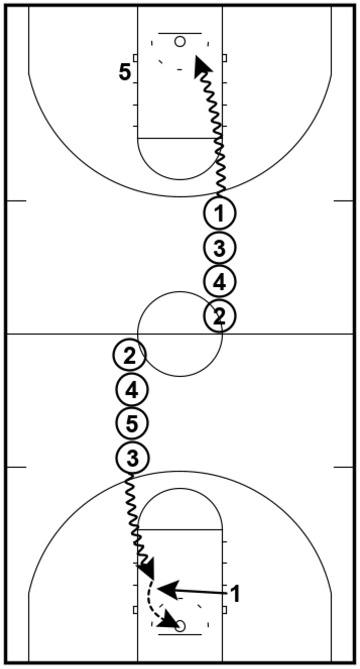
- The first player in line should stand in triple threat position. To quickly begin their dribble, they throw the ball down towards their right-hand side, and drive to the basket.
- The extra player on the left block will give one of three different signals, to inform the driving player which finish they should attempt.
- If the player on the left block runs and stands directly underneath the basket, the offensive player should make a powerful move, directly to the basket, and finish as high as possible.
- If the player on the left block runs and stands between the driver and the basket, outside of the charge circle), the driver should shoot a short ‘floater’ over the top of the defender’s head, without running into them (if your court has no charge circle, have them stand a 4-5 feet in front of the basket).
- If the player on the left block runs across the keyway to the right block, the driver should make a ‘change of direction’ move with their footwork, and finish on the left-hand side of the basket. An example of this type of move would be a ‘euro-step’ or a ‘pro-hop’.
1v1 ‘Ball on Back’ (20 to 30 minutes)
Setup:
The defender starts by standing on the 3pt line, facing the basket. The offensive player stands behind the defender and places the ball upon the defenders back.
Instructions:
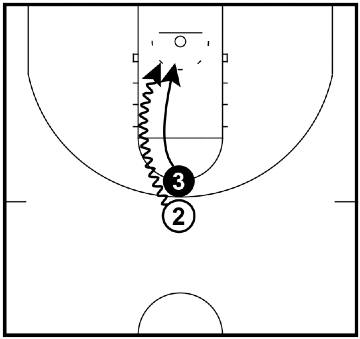
- The drill begins when the offensive player takes the ball off the defensive player’s back.
- Play until either the offensive player scores or the defensive player gets the ball.
- The defender facing away provides the offensive player an advantage, which they can take with a fast, decisive move to the basket!
2v2 ‘Rugby’ (30 to 45 minutes)
Setup:
The ball starts out of bounds on the baseline.
Instructions:
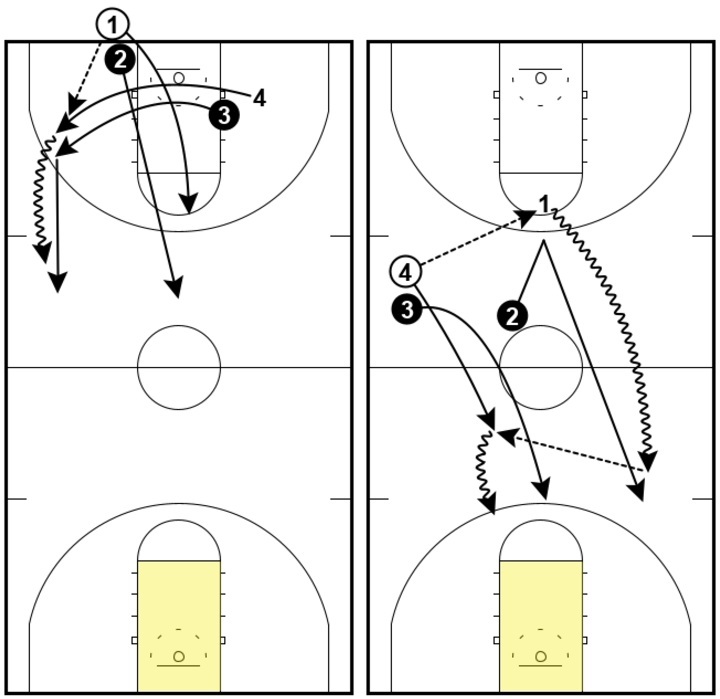
- The offensive inbounder must pass the ball into the court to his teammate.
- After this first pass, the offensive team may only pass backwards.
- The goal is to get the ball into the key-way at the other end of the court.
- The defensive team must work on having a player closely guarding the ball. His teammate should be behind the line of the ball, narrowing the space that the offensive player has to dribble.
3v3 ‘Hockey’ (45 to 60 minutes)
Setup:
This is a game of 3v3 in the full court, with one extra rule which allows the defense to apply more full-court pressure.
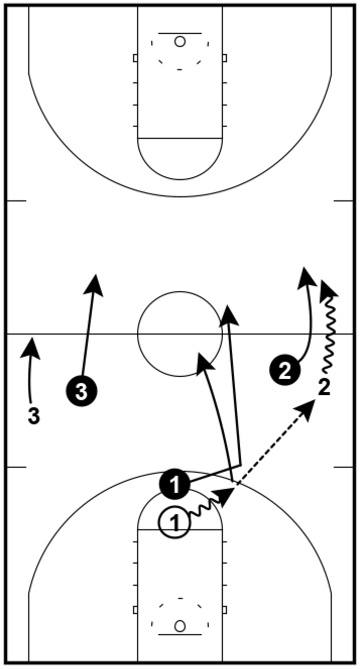
Rule:
Borrowing from Ice Hockey’s ‘off-side’ rule, the offensive ball-handler must be the first offensive player to cross the half-court line. Before the ball is dribbled across the half-court line, no other offensive player may be in the front half of the court.
This prevents offensive players from sprinting ahead for easy long passes, and allows the defense to practice their full-court defense more effectively.
Find, Hit, Get (60 to 70 minutes)
Setup:
Two players start on the top corners of the keyway (offence), and another two players start on the blocks (defence).
Instructions:
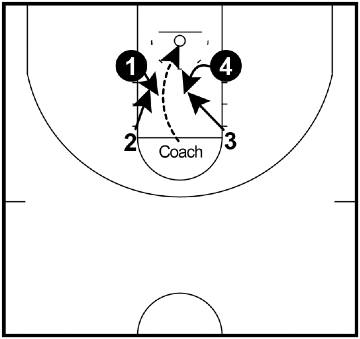
- Coach shoots the ball from the foul-line.
- Once the ball is shot, all 4 players can move to rebound.
- Upon the shot, the two defensive players yell:
“FIND!”, and run towards the offensive players.
“HIT!”, and make contact with the offensive players.
“GET!”, and attempt to rebound the ball. - Whichever team gets the ball becomes offence, and attempt to score on the basket the ball was just shot upon.
- Players rotate positions after either team has scored.
Team Strategy (70 to 90 minutes)
By the time your players are 15 or older, they’ll need a couple of set plays to score with.
If you do not already have a few plays up your sleeve, check out this link below.
28 Basketball Plays to Dominate Any Defense
When practicing set plays, make sure to use all the players you have available!
5v0 might make your plays look great, but they won’t look great once you get to the game!
Practice your plays with defenders.
To begin with, have them not steal the ball or try and blow up your play, but make sure you build towards practicing your plays against a live defence!
If you only have 8 players at training, 3 defenders is better than 0 defenders!
Scrimmage/SSG (90 to 115 minutes)
With 3 different focuses for this training session, we can use small-sided games or 5v5 scrimmages to apply what we have learned to a game!
3v3 Small-Sided Game (90 to 100 minutes)
To emphasize finishing on the basket, we will change the scoring system!
Play either until a certain score, or for an amount of time.
Scoring System:
- Score inside the bottom half of the keyway= 3 points.
- Score inside the top half of the keyway= 2 points.
- Score inside the 3pt line, but outside of the keyway= 1 point.
- 3pt Basket = 0 points, but the opponent’s score goes back to 0.
Making mid-range baskets only worth 1 point will encourage players to keep driving, and not settle for pull-up jump-shots.
Creating a large consequence for the defense giving up a made 3pt shot will cause them to close out harder, creating more driving opportunities for the offense.
5v5 Scrimmage (100 to 115 minutes)
To focus on full-court defense and rebounding, we introduce two simple rules to influence how the game is played.
Rule 1:
Once the defense first gets the ball (on a made basket, a rebound, or a steal), the player who has the ball must place it upon the ground. Another teammate shall run across and pick up the ball, and the game shall resume. The new defense cannot defend the ball until it has been picked up by the other team. This gives the defense a chance to set up their full-court defense, on every change of possession.
Rule 2:
If the offensive team gets an offensive rebound, they get a “power-play”. They have a free chance to score, without any threat of losing the ball. Once the defense has the ball (on a rebound or a steal), the game stops, and the offense get the ball back.
Coaching Points:
We recommend that you play mini-games, and coach in between each game. Play until either team has scored two baskets. After the mini-game, bring the teams in, and coach them for 30-45 seconds. Make substitutions, and send them back out onto the court!
Coach in dot-points, not paragraphs.
Cool Down (115 – 120 Minutes)
- Jog to the other end of the court and back.
- Walk to the other end of the court and back.
- Sit down, and do some static stretches.
The cooldown stretching gives the coach some time to have a conversation with the players about training, and potentially some quick information about the next opponent.
[divider style=’full’]
Conclusion:
The biggest thing I want you to take away from this article is that you need a basketball practice plan for every practice.
A planned practice is more efficient, your players will improve quicker, and you’ll be a far better coach.

